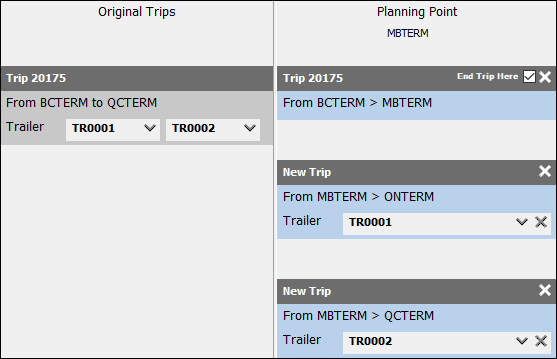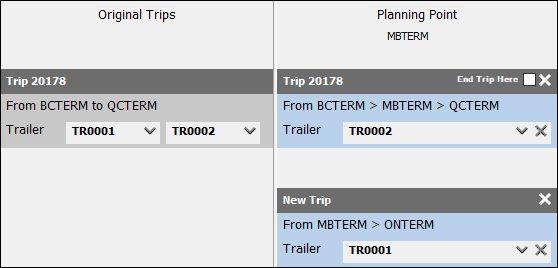Split trips
Trip Operation Planning has several options to split trips. This topic covers basic splits. For information on combined merges and splits, see this topic.
Split with new trips
The Split with new trips option divides an existing trip into two or more new trips at a shared split zone. This option is only available if you have only one original trip.
When you select this option, the original trip is brought into the Operation or Planning Point column, but it is not actively used for the trip plan. You can drag the original trip into the column, but it will conflict with the new split trips.

-
Right-click in the Original Trips column.
The shortcut menu opens. -
Select Split with new trips.
The Select the Split Point Zone window opens. -
Select the Zone or Client tab.
-
Enter a value in the Filter field to populate the window with zone IDs.
This field is case-sensitive.
-
Select a zone ID.
-
Select OK.
The original trip is marked to end and the new split trips appear. -
Select Execute.
Trip Operation Planning closes.
Operation Point and Planning Point
The new split trips appear in either an Operation Point or Planning point column depending on the split zone you choose:
-
If Operation Point is used, the actions occur immediately.
-
If Planning Point is used, the system creates the split trips as requested. A waypoint is added to the original trip. When the original trip reaches the split zone, you can move the split trips as needed.
-
If the original trip’s current zone matches the split zone, the new trips appear in an Operation Point column.
-
If the original trip’s current zone does not match the split zone, the new trips appear in a Planning Point column.
You can change the column between Operation Point and Planning Point by selecting  Change Point Type. However, there is a security setting that may prevent you from changing the column type manually.
Change Point Type. However, there is a security setting that may prevent you from changing the column type manually.
The security setting is Allow use of Operation Point movements if Trip(s) are not present in the selected zone:

If this setting is not enabled and the trip is not currently at the split zone, then the action appears in a Planning Point Column and cannot be manually changed to an Operation Point column.
Operational Plan ID (OP Plan ID)
When you execute an operational plan, all the trips involved are linked with an OP Plan ID.
For example, if you execute this Split with new trips plan:

You can see the shared Op Plan ID in the trip grids in Multi Mode Dispatch or Dispatch:

Advancing split trips
With this workflow, the new split trips cannot be moved until the original trip is completed.
The following trips exist in the example plan above:
-
Trip 20175 is the original trip with both trailers and their bills. It goes from BCTERM to MBTERM.
-
Trip 20176 is the first split trip with one of the trailers and its bills. It goes from MBTERM to QCTERM.
-
Trip 20177 is the second split trip with the other trailer and its bills. It goes from MBTERM to ONTERM.
In this case, trips 20176 and 20177 cannot be started until the original trip 20175 arrives and is completed at MBTERM. If you try to start them before the original trip completes, you get an error:

Split an existing trip
The Split trip option divides an existing trip’s resources between itself and two or more new trips at a shared split zone. This option is only available if you have only one original trip.
When you select this option, the original trip you choose is brought into the Operation or Planning Point column as one of the split trips. New split trips are then created per resource from the original trip.

-
Right-click in the Original Trips column.
The shortcut menu opens. -
Select Split Trip.
The Select the Split Point Zone window opens. -
Select the Zone or Client tab.
-
Enter a value in the Filter field to populate the window with zone IDs.
This field is case-sensitive.
-
Select a zone ID.
-
Select OK.
The original trip is brought into the Operation or Planning point column and one or more new trips appear. Resources divide between the trips. -
Select Execute.
Trip Operation Planning closes.
Operation Point and Planning Point
The split trips appear in either an Operation Point or Planning Point column depending on the split zone you choose:
-
If Operation Point is used, the actions occur immediately.
-
If Planning Point is used, the system creates the split trips as requested. A waypoint is added to the original trip. When the original trip reaches the split zone, you can move the split trips as needed.
-
If the original trip’s current zone matches the split zone, the split trips appear in an Operation Point column.
-
If the original trip’s current zone does not match the split zone, then the split trips appear in a Planning Point column.
You can change the column between Operation Point and Planning Point by selecting  Change Point Type. However, there is a security setting that may prevent you from changing the column type manually.
Change Point Type. However, there is a security setting that may prevent you from changing the column type manually.
The security setting is Allow use of Operation Point movements if Trip(s) are not present in the selected zone:

If this setting is not enabled and the trip is not currently at the split zone, then the action appears in a Planning Point Column and cannot be manually changed to an Operation Point column.
Operational Plan ID
When you execute an operational plan using Split trip, all trips involved are linked with an OP Plan ID.
For example, if you execute this Split trip plan:

You can see the shared Op Plan ID in the trip grids in Multi Mode Dispatch or Dispatch:

Advancing split trips
With this workflow, the split trips cannot be moved until the original trip reaches the split zone.
The following trips exist in the example plan:
-
Trip 20178 is the original trip with both trailers and its bills. This trip goes from BCTERM to MBTERM, is split, then one of the trailers and bills continues to QCTERM.
-
Trip 20179 is the new split trip with the other trailer and its bills. This trip goes from MBTERM to ONTERM.
In this case, trip 20179 cannot be started until the original trip 20178 has arrived at MBTERM. If you try to start it early, you get an error:
